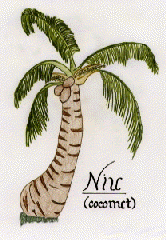|
Plants Used for Building Canoes
Chad Baybayan, Rowena Keaka, Melissa Kim, Beatrice Krauss, and Mollie Sperry
[Illustration below: Niu / Coconut, by Melanie Lessett]
 The Hawaiian environment provided all the necessary items to construct and provision a canoe. The native Polynesian possessed a tremendous ability in discovering the many uses his natural environment provided for him. It is this resourcefulness that allow ed him to move freely upon the ocean. The following is a list of plants and their uses in building canoes. The Hawaiian environment provided all the necessary items to construct and provision a canoe. The native Polynesian possessed a tremendous ability in discovering the many uses his natural environment provided for him. It is this resourcefulness that allow ed him to move freely upon the ocean. The following is a list of plants and their uses in building canoes.
- 'akoko: paint, dye
- 'uhaloa: paint, dye
- 'aka'akai: paint, dye
- 'ama'u: paint, dye
- olona: lashing
- 'ie'ie: lashing
- niu: sennit, water-sealant
- hala: sails, covers
- ipu: bailer
- koa: hull, manu, seats, gunnels, spar, mast, paddles
- 'ulu: hull, manu, gunnels, seats, caulking
- kukui: hulls, paint
- hau: 'iako (outrigger boom), ama (outrigger float), boom, paddles
- wiliwili: ama (outrigger float)
(Originally published in Polynesian Seafaring Heritage, Honolulu: Kamehameha Schools, 1980, edited by Cecilia Kapua Lindo and Nancy Alpert Mower.)
People have made and used cordage for many centuries. It has been used to attach one object to another and to lift, pull, or secure things into place. Cordage has been not only useful but also decorative. Because of the various uses of cordage, individual s have created many ways of knotting and lashing. 'Aha (coconut sennit cordage) is still being made in many places in the Pacific. Both the green and dry husks of the coconut are used.
There are several ways in which Polynesians prepare the coconut fibers. One method is to break the husk apart into sections. Each section is then turned over to expose the slick outer skin. This outside portion is then pounded. Pounding aids in breaking t he inner fibers away from the outer skin. The sections are next soaked in seawater for several weeks before the long fibers that are worked into cordage are removed. Another method is to break the husk apart, then remove some of the long fibers which are soaked in seawater for eight weeks. Pacific Islanders who use the green husk just remove the long fibers by pulling the husk apart and working the fibers into cordage.
Canoe sennit, which must be a very tight braid, is extremely difficult to make. Because of the roughness of the fibers, only a few lengths can be made in a day.
Several different kinds of cordage were used throughout Hawai i and the Pacific. Bark from the hau (hibiscus) was easier to work with than coconut fibers. Hau bark strips are longer and when braided or twisted are very strong. Hau cordage was used for sec uring items such as umeke (bowls / calabashes), or rolls of kapa or lauhala.
Making Coconut Cordage (Sennit)
- Husk mature dry coconuts and break into 8-10 sections. Remove shorter fibers next to outer shell, at both ends of the husk, and discard.
- Soak sections for 2 weeks, or until they are easy to work. Soaking fibers in running water helps in the cleaning process. Weight them down with a brick or stone when soaking.
- Remove sections--work sections by twisting or use table edge and press sections over the edge; peel and discard outer skin.
- Beat each section with a wooden mallet. Use a piece of hard wood or a flat stone for an anvil.
- Start beating. Beat sections starting from the center and working to the edge. Turn section around, repeat process to remove extraneous matter.
- Rinse to separate"chaff" from fibers. Shaking the bundle helps to remove the"chaff." Tools like shells or a strong comb help in removing extraneous material. Work through fibers. This process cleans and untangles fibers. Tie each section around middle. This is for easy handling.
Making Hau Cordage
- Cut hau (hibiscus) branch. Select a straight branch with few branch scars.
- Strip outer bark (bast) using a sharp instrument ('opihi shell or knife). Peel the bark away from the branch.
- If a fine cordage is desired, scrape off the outer bark.
- Soak in water for about a week. Running water is desirable (a stream would be ideal), or change tap water periodically to prevent the bark from rotting. The object of soaking is to soften the fibers and separate them into layers .
- Take strips of the material and braid or twist to make cordage.
- Take three strands of fiber, start each one about l" from the other. Place right palm over fibers; place fibers on leg; firmly roll downward towards knee. Keep adding fibers to lengthen the single fiber thread.
Another method to use when making hau cordage:
- After all the fibers are cleaned, tie 15 fibers together with a knot. This will make cordage.
- Divide the fibers in 3 groups of 5 fibers. It is better if the groups of fibers are not the same length.
- The knot may be held between your toes or tacked at the edge of a table. Braid the fibers.
- Before you reach the end of a fiber group, add in a new group of 5 fibers. Individual fibers may also be spliced in as needed.
|

